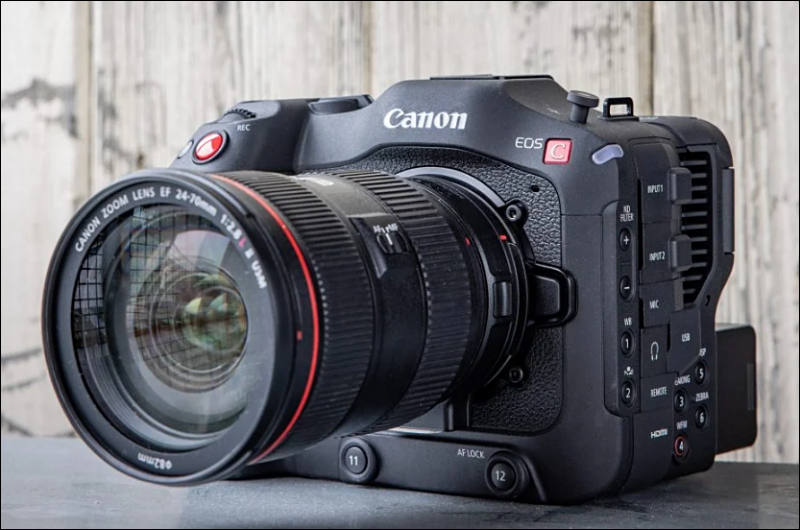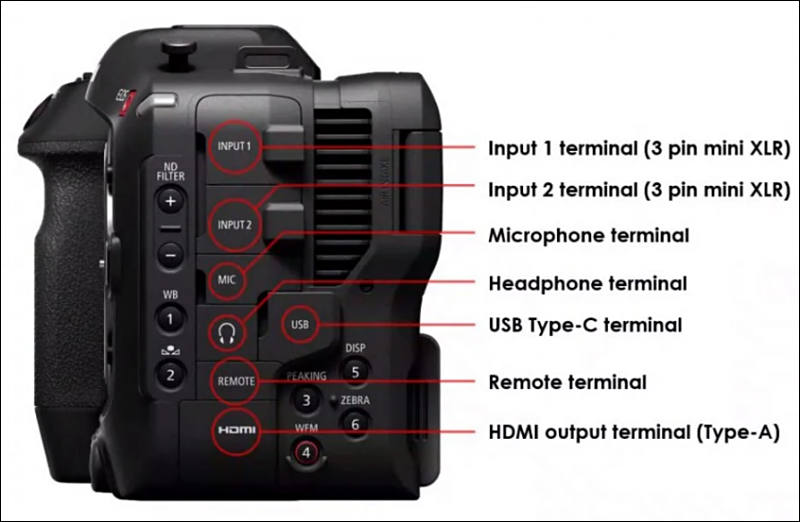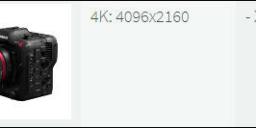
-

Specs
- New Direct Touch Menu System
- Coordinated Electronic Image Stabilization
- Two built-in Mini XLR inputs
- Time-code input/output terminal
- Custom picture processing via import of 3D LUTs and recording to Look Files
- Dual-SD card slots
- Built-in stereo mic
- Support for optional Canon RC-V100 remote control
- $5499 at

-
Canon U.S.A., Inc., a leader in digital imaging solutions, today announced a firmware update for the EOS C70 4K Digital Cinema Camera that implements sought after features such as Cinema RAW Light internal recording as well as Frame and Interval recording modes. The added features allow the EOS C70 to be better paired with the EOS C500 Mark II and EOS C300 Mark III workflows, and come as a direct result of end-user feedback from professionals.
Cinema RAW Light Internal Recording
The addition of Cinema RAW Light internal recording to the EOS C70 camera further enhances the recording capabilities of what’s already a powerful digital imaging machine. This compact cinema camera can now capture 12-bit Cinema RAW Light internally to compatible SD cards. Cinema RAW Light captures the widest dynamic range from the Dual Gain Output sensor (16+ stops total) and allows the most flexibility to grade captured content. Three quality settings of Cinema RAW Light will make their way into the EOS C70 via the firmware update. The settings are: RAW HQ (high quality), RAW ST (standard quality), and RAW LT (light recording). All three modes are 12-bit regardless of frame rate. Lastly, Cinema RAW Light is compatible with Proxy and Double-Slot recording.
Frame and Interval Recording Modes
The addition of Frame and Interval Recording modes is a direct result of user feedback, and adds even more recording flexibility to the EOS C70 camera by allowing easy creation of stop motion and time-lapse sequences when recording in the XF-AVC and MP4 formats. Frame recording is for stop motion capture, and every press of the record button captures a user-determined number of frames. Interval Recording sets the interval and number of frames to be captured for time-lapse sequences. Both recording modes help operators further tell their story in a more creative and inspiring form and are easy to use.
The firmware update will be available for download in March 2022*. For more information, please visit, usa.canon.com.
-
Firmware update 1.0.2.1
- Adds [EOS Standard] and [EOS Neutral] to the Custom Picture Presets.
- Adds EF lenses compatible with EF-EOS R 0.71x Mount Adapter.
- CN-E14mm T3.1 L F
- CN-E20mm T1.5 L F
- CN-E24mm T1.5 L F
- CN-E35mm T1.5 L F
- CN-E50mm T1.3 L F
- CN-E85mm T1.3 L F
- CN-E135mm T2.2 L F
- EF 14mm f/2.8L II USM
- EF 24mm f/1.4L II USM
- EF 35mm f/1.4L II USM
- EF 50mm f/1.2L USM
- EF 85mm f/1.2L II USM
- EF 135mm f/2L USM
-
Firmware version 1.0.1.1:
- Adds ITU-R.BT.709 standard compliant Gamma[BT.709 Standard / BT.709] the to the Custom Picture.
- Adds [Whole Area] to the AF Frame option so the camera focuses automatically on a subject at the center of the screen.
- Object or Face Tracking can now be initiated by touching the LCD monitor during 'Whole Area' AF.
- Adds [2x] option to the Magnification.
- Adds [Mask 100%] to the [Aspect Marker] and [Safe Area Marker].
- Adds "B&W during Magn." as an option to the Assistance Function menu.
- Adds View Assist function to video output from the HDMI OUT terminal.
- Adds EF lenses compatible with EF-EOS R 0.71x Mount Adapter.
- EF16-35mm f/2.8L II USM
- EF16-35mm f/4L IS USM
- EF24-105mm f/4L IS USM
- EF70-200mm f/2.8L IS II USM
- EF70-200mm f/2.8L IS III USM
- EF70-200mm f/4L IS USM
- EF70-200mm f/4L IS II USM
- Changes to display the AF frame only when operating the AF, while using with EF-EOS R 0.71x Mount Adapter
- Adds Wi-Fi adapters tested for use with the camera.
- ASUS USB-AC68
- TP-LINK Archer T9UH
-
Firmware Version 1.2.0 adds full function support for these 7 lenses when used with the EOS C70:
- EF 16-35mm f/2.8L II USM
- EF 16-35mm f/4L IS USM
- EF 24-105mm f/4L IS USM
- EF 70-200mm f/2.8L IS II USM
- EF 70-200mm f/2.8L IS III USM
- EF 70-200mm f/4L IS USM
- EF 70-200mm f/4L IS II USM
-
But does this camera really need to be that big with this shape? They could have done the usual brick and instead that shape that resembles the classic camera form factor makes it look like it came out of Toy Story. Who will use it by hands?
-
In Netflix approved list now

https://help.prodicle.com/hc/en-us/articles/115001787532-Cameras-and-Image-Capture

 sa15871.jpg734 x 133 - 13K
sa15871.jpg734 x 133 - 13K -
@endotoxic, it is $5.5K, not $4K
-
All in All, this camera for me, is the most solid choice of all the cine line.
Why?
Is $4K and it’s Better than S1H. Punches well beyond its weight and really doesn't seems te need raw output for what it’s used. 16 stops and nd filters with grate color rendition. 10 bit 4:2:2. 4K 120fps (120fps 8bit only) but there are all main things really well built. Dual pixel autofocus on 120fps and audio as separate file !! 180fps 2k a grate sensor with DGO. Expect 240fps in future upgrades for 2k (LSI supports it) The menu system is really good and complete it even has black balance for good and clean blacks, and gives you that dual gain Values that gives the real 16stops at just the right settings. Don’t forget the vertical mode!!! Lol.
Personally I prefer 2 of this than two c300 mkiii using raw in same situation. They are smaller brings up same IQ and much more practical with same autofocus.
In case of raw, use a red or better cam. Case closed.
If this little beast would output raw all c200 c300 mki mkii and mkiii. If this would output raw and support 6k why bother to Buy C500???
This little beast It’s like the Mike Tyson of the cameras. It’s a small heavyweight that can knock out cold other much bigger of it same class, for real.
-
Am pleasantly pleased and surprised (as the C100/C200 never had this) that the new Canon C70 has Timecode I/O.
Although I bet most C70 buyers would wish that BNC connector was for HD-SDI instead of TC!
As for all the Vertical Video haters, I do tend to agree in preferring the wide screen look rather than the Skyscraper Look. But in the end you have to do what the clients want, and what will give them the best return, and for many lower budget C70 shooters then they'll be doing a lot of shooting for social media.
-
@chopnshoot "It's the viewers." The viewers are fuked up dont now why you didn't understand by now... You had al the time in the world...
-
Vertical videos perform better on social media. It's not about the creator's refusal to rotate their phones. It's the viewers.
-
off topic...
what is unbelievable with vertical video that serious brands jump up on this because they assume that TickTocks are too stupid to turn their phone. And they accept a presentation of their product which does not fit in the vertical frame.
-
Most important feature presently in the age of Instagram, Tiktok and idiots who watch all this.
-
Vertical shooting capabilities!!!
-
PR
Canon's EOS C70 brings the power of the RF Mount to its Cinema EOS System range for the first time.
Canon's smallest and lightest Professional Cinema camera launches alongside a new EF-EOS R Mount adapter to unleash the full creative potential of Canon's entire EF-Series and RF-Series lens line-up.
Canon launches the EOS C70 -- a compact, versatile video camera that is the first to combine the powerful image quality of Canon's Cinema EOS System range with the portability and flexibility of its EOS R line-up. For the first time, filmmakers using a Canon Cinema EOS System camera can enjoy the incredible possibilities of the powerful RF-Series lens range.
The EOS C70's powerfully compact design -- complete with professional interfaces and input/output terminals and ports -- makes it perfectly suited for a broad range of uses including documentaries, productions of all sizes, newsgathering, and events such as weddings. High production social media content has also never been easier to capture thanks to the EOS C70's vertical shooting capability. The EOS C70's compact size yet expansive features enable filmmakers to shoot handheld or on a drone or gimbal, giving them enhanced creative freedom. What's more, it offers multiple recording formats to SD cards -- including 4K up to 120 fps in 4:2:2 10-bit in XF-AVC (All-I or Long-GOP), and MP4 in HEVC (H.265) or H.264 -- providing filmmakers with the ability to meet diverse production requirements.
Also launching today is the Canon Mount Adapter EF-EOS R 0.71x -- an EF Lens to RF Mount adapter giving filmmakers the freedom to use the entire EF lens line-up1 with the EOS C70, optimising compatibility across two of Canon's most popular lens lines. When paired with the EOS C70, the Mount Adapter EF-EOS R 0.71x employs an optical conversion to capture a Full Frame angle of view of an EF lens even when used with a Super 35mm sensor, as well as an increased light transmission of approximately 1-stop. The adapter enables full communication between three EF lenses and the camera body -- EF 16-35mm f/2.8L III USM, EF 24-70mm f/2.8L II USM, and EF 24-105mm f/4L IS II USM- providing continued support for Canon's extensive range of EF lenses2. Auto Focus, peripheral illumination and chromatic aberration correction, and the transfer of lens metadata are also fully supported when using the Mount Adapter EF-EOS R 0.71x3.
*The Canon EF-EOS R 0.71x Mount Adapter for the EOS C70
Powerfully compact professional cinema capabilities
The EOS C70 bridges the gap between two Canon product portfolios -- the Digital Interchangeable Lens camera line-up and the powerful Cinema EOS System cameras -- with the short flange back design of Canon's RF Mount making the compact design of the EOS C70 possible. While the camera is the smallest and lightest in Canon's Cinema EOS System line-up, it's packed with features that support a versatile range of professional video requirements. It has 13 assignable buttons, a multi-functional hand grip for ease of operability, professional input/output terminals including HDMI and 2x mini XLR terminals for audio, as well as an independent ventilation system. Furthermore, a new, thinner ND filter system gives up to 10-stops of ND filtration 4, providing filmmakers with flexibility to control exposure while keeping control over the depth of field and enabling significant bokeh, even when using a high-speed lens.
Powering cinema with the consistent and stable performance of RF
Canon's RF lens line-up is renowned for its excellent image quality and functionality. The Mount technology is engineered to provide advanced benefits for video use and is ideal for Canon's Cinema EOS System range. Such capability gives filmmakers using the EOS C70 a comprehensive choice of high- quality lenses from the expanding RF range -- including telephoto, zoom, high-quality primes, wide aperture and macro lenses. For optimal image stabilisation, the EOS C70 enables Combination IS which brings together the Optical IS in RF lenses and the Electronic IS in the camera body for outstanding stabilisation performance -- even when shooting handheld. The enhanced communication capability between the lens and the camera also unlocks additional features such as the ability to display the object distance on the camera's LCD monitor.
Impeccable 4K image quality
Taking advantage of its Super 35mm Dual Gain Output (DGO) sensor, seen in the highly acclaimed EOS C300 Mark III, the EOS C70 delivers exceptional image quality with over 16 stops of dynamic range. Much like the EOS C300 Mark III, the EOS C70 produces the same true-to-life, cinematic colours, exceptionally clean low-light image quality and superb HDR acquisition capabilities. Thanks to the DGO sensor, and powerful DIGIC DV 7 processor the EOS C70 is an ideal choice for professionals looking to produce high-quality content in 4K. It also supports slow motion capture with 4K 120p recording -- with Dual Pixel CMOS AF support, as well as audio recording. For those who desire higher frame rates, 180p is also available in Super16 mode. Recording to Dual SD cards in Canon's XF-AVC format with 4K 4:2:2 10-bit, the EOS C70 captures high resolution footage for a wide range of applications, from documentary and journalism to music videos and web-based content.
Enhanced support functions
The EOS C70 boasts a number of 'firsts' for the Cinema EOS System range. In addition to supporting Canon's renowned Dual Pixel AF System, it is also the first Cinema EOS System camera to feature the revolutionary EOS iTR AF X (Intelligent Tracking and Recognition) system seen in the newly-launched EOS R5. The system uses a face and head detection algorithm that works in conjunction with Face Detection AF to greatly improve the reliability of focusing on and tracking the subject. Likewise, the EOS C70 also introduces Auto ISO to the Cinema EOS System range for the first time.
Canon also breaks new ground with the EOS C70, as the first Cinema EOS System camera with a dedicated vertical shooting mode, designed to support the capture of content for social media and digital signage.
Simple storage and workflows
The EOS C70 features several recording options at resolutions from 4K, UHD, 2K, and Full HD. Designed for content producers who want to streamline their post-production workflows, the Dual SD card slots support high-speed UHS-II media -- with a variety of configurations such as double slot, relay and simultaneous recording. For the first time in a Cinema EOS camera, it is now possible to record different formats, resolutions and bit depths on each media card slot, offering a truly flexible workflow.
Also launching today is the CJ20ex5B IASE S, a 2-in-1 UHDxs-class lens with a powerful 20x zoom range and 5mm wide-angle which expands Canon's range of industry-leading 4K broadcast lenses for 2/3- inch sensor cameras.
EOS C70 Key Features:
- The Cinema EOS C70 uses Canon's new 4K Super 35mm DGO sensor with HDR capabilities
- High frame rate 4K shooting at 120fps with audio recording and DPAF
- Dual SD card slots allowing for simultaneous recording in multiple formats
- Improved Dual Pixel Auto Focus with intelligent tracking and a new touch user interface
- Compatible with the new Mount Adapter EF-EOS R 0.71x giving users access to the extensive range of Canon EF mount lenses
- RF Mount system
For more information about the EOS C70 and Mount Adapter EF-EOS R 0.71x, visit: https://www.canon.com.au/cameras/eos-c70
1. Full-function lenses can communicate various information with the EOS C70. The following three lenses are full supported without a firmware update: EF 16-35mm f/2.8L III USM, EF 24-70mm f/2.8L II USM, EF 24-105mm f/4L IS II USM. Lenses other than full-function lenses can also shoot with a brighter f-number with an equivalent angle of view as full frame. We will continue to expand the range of full-function lenses by gradually upgrading the firmware. 2. As of September 25, 2020, the following lenses are compatible: the EF16-35mm f/2.8L III USM (released in October 2016), the EF24-70mm f/2.8L II USM (released in September 2012), the EF24-105mm f/4L IS II USM (released in November 2016). Canon plans to gradually expand the list of compatible lenses by providing free- of-charge firmware updates in 2021. EF lenses are still compatible with the camera, but Canon recommends that firmware updates be installed in order to effectively utilise functions which link the camera and lens. 3. Available for full-function lenses which include the EF 16-35mm f/2.8L III USM, EF 24-70mm f/2.8L II USM, EF 24-105mm f/4L IS II USM Lenses. Canon plans to gradually expand the list of compatible lenses by providing free-of-charge firmware updates in 2021. 4. The ND filter is designed to fit into the 20mm flange back RF system. Motorised variable ND filter (2/4/6/8/10 stop)
Howdy, Stranger!
It looks like you're new here. If you want to get involved, click one of these buttons!
Categories
- Topics List23,991
- Blog5,725
- General and News1,353
- Hacks and Patches1,153
- ↳ Top Settings33
- ↳ Beginners256
- ↳ Archives402
- ↳ Hacks News and Development56
- Cameras2,367
- ↳ Panasonic995
- ↳ Canon118
- ↳ Sony156
- ↳ Nikon96
- ↳ Pentax and Samsung70
- ↳ Olympus and Fujifilm101
- ↳ Compacts and Camcorders300
- ↳ Smartphones for video97
- ↳ Pro Video Cameras191
- ↳ BlackMagic and other raw cameras116
- Skill1,960
- ↳ Business and distribution66
- ↳ Preparation, scripts and legal38
- ↳ Art149
- ↳ Import, Convert, Exporting291
- ↳ Editors191
- ↳ Effects and stunts115
- ↳ Color grading197
- ↳ Sound and Music280
- ↳ Lighting96
- ↳ Software and storage tips266
- Gear5,420
- ↳ Filters, Adapters, Matte boxes344
- ↳ Lenses1,582
- ↳ Follow focus and gears93
- ↳ Sound499
- ↳ Lighting gear314
- ↳ Camera movement230
- ↳ Gimbals and copters302
- ↳ Rigs and related stuff273
- ↳ Power solutions83
- ↳ Monitors and viewfinders340
- ↳ Tripods and fluid heads139
- ↳ Storage286
- ↳ Computers and studio gear560
- ↳ VR and 3D248
- Showcase1,859
- Marketplace2,834
- Offtopic1,320







